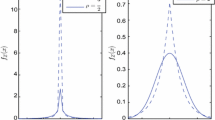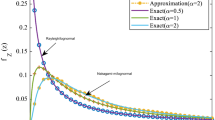Abstract
The composite \(\alpha {-}\mu /\)gamma distribution is considered in this paper. Specifically, we derived closed-form expressions for the power probability density function (PDF) and the cumulative density function (CDF). We then use the PDF and the CDF to derive novel closed-form expressions for the outage probability, the average symbol error rate, and the average channel capacity over the composite \(\alpha {-}\mu /\)gamma fading channels. All derived expressions are valid for integer and non-integer values of the fading parameters. Some representative numerical examples are provided to study the impact of the fading and shadowing parameters on the system performance. Furthermore, the numerical results are compared with Monte-Carlo simulations. Both results demonstrate excellent agreement which validates our analysis.









Similar content being viewed by others
References
Simon, M. K., & Alouini, M. (2005). Digital communication over fading channels (2nd ed.). New York: Wiley.
Hansen, F., & Finn, M. I. (1977). Mobile fading—Rayleigh and lognormal superimposed. IEEE Transactions on Vehicular Technology, 26(4), 332–335.
Raghavan, R. S. (1991). A model for spatially correlated radar clutter. IEEE Aerospace and Electronic Systems, 27(2), 268–275.
Abdi, A., & Kaveh, M. (1998). \(k\) distribution: An appropriate substitute for Rayleigh-lognormal distribution in fading shadowing wireless channels. Electronics Letters, 34(9), 851–852.
Yilmaz, F., & Alouini, M. (2010). A new simple model for composite fading channels: Second order statistics and channel capacity. In Proceedings of the 2010 7th International Symposium on Wireless Communication Systems, ISWCS (pp. 676–680)
Shankar, P. M. (2004). Error rates in generalized shadowed fading channels. Wireless Personal Communications, 28, 233–238.
Badarneh, O. S. (2015). Error rate analysis of \(m\)-ary phase shift keying in \(\alpha {-}\eta {-}\mu \) fading channels subject to additive Laplacian noise. IEEE Communications Letters, 19(7), 1253–1256.
Shankar, P. (2013). Maximal ratio combining (MRC) in shadowed fading channels in presence of shadowed fading cochannel interference (CCI). Wireless Personal Communications, 68(1), 15–25.
Lei, X., & Fan, P. (2010). On the error performance of \(M\)-ary modulation schemes on Rician–Nakagami fading channels. Wireless Personal Communications, 53(4), 591–602.
Kapucu, N., Bilim, M., & Develi, I. (2014). A closed-form MGF expression of instantaneous SNR for weibull fading channels. Wireless Personal Communications, 77(2), 1605–1613.
Lee, H. (2015). High-SNR approximate closed-form formulas for the average error probability of \(M\)-ary modulation schemes over Nakagami-\(q\) fading channels. In J. Park, Y. Pan, H.-C. Chao, & G. Yi (Eds.), Ubiquitous Computing Application and Wireless Sensor, Series Lecture Notes in Electrical Engineering (Vol. 331, pp. 11–22). Netherlands: Springer.
Miridakis, N. I. (2015). Performance analysis of EGC receivers over generalized-\(\cal{K}\) (\(\cal{K}_{G}\)) fading channels. Wireless Personal Communications, 80(1), 167–173.
Zhang, J., Matthaiou, M., Tan, Z., & Wang, H. (2012). Performance analysis of digital communication systems over composite \(\eta {-}\mu \)/gamma fading channels. IEEE Transactions on Vehicular Technology, 61(7), 3114–3124.
Ansari, I. S., Yilmaz, F., Alouini, M.-S., & Kucur, O. (2014). New results on the sum of gamma random variates with application to the performance of wireless communication systems over Nakagami-m fading channels. Transactions on Emerging Telecommunications Technologies,. doi:10.1002/ett.2912.
Stamenović, G., Panić, S. R., Stefanović, D. R. Č., & Stefanović, M. (2014). Performance analysis of wireless communication system in general fading environment subjected to shadowing and interference. EURASIP Journal on Wireless Communications and Networking, 2014, 1–8.
Sofotasios, P. C., & Freear, S. (2015). A generalized non-linear composite fading model. CoRR, arXiv:1505.03779.
Yacoub, M. D. (2002). The \(\alpha {-}\mu \) distribution: A general fading distribution. In Proceedings of the IEEE PIMRC, September 15–18, 2002, pp. 629–629.
Shankar, P. M. (2011). Statistical models for fading and shadowed fading channels in wireless systems: A pedagogical perspective. Wireless Personal Communications, 60(2), 191–213.
Prudnikov, A. P., Brychkov, Y. A., & Marichev, O. I. (1990). Integrals and series: More special functions (Vol. 3). New York: Gordon & Breach Science Publishers, Inc.
Kilbas, A., & Saigo, M. (2004). H-transforms : Theory and applications (Analytical Method and Special Function) (1st ed.). Boca Raton: CRC Press.
Gradshteyn, I. S., & Ryzhik, I. M. (2007). Table of integrals, series, and products (7th ed.). California: Academic Press.
Mathai, A., & Saxena, R. (1978). The H-function with applications in statistics and other disciplines. New Delhi: Wiley Eastern.
Nakagami, M. (1960). The \(m\)-distribution-a general formula of intensity distribution of rapid fading. In Proceedings of the symposium statistical methods radio wave propagation (pp. 3–36). New York, NY, USA.
Author information
Authors and Affiliations
Corresponding author
Rights and permissions
About this article
Cite this article
Badarneh, O.S. Performance Evaluation of Wireless Communication Systems over Composite \({\varvec{\alpha}}{-}{\varvec{\mu}}/\)Gamma Fading Channels. Wireless Pers Commun 97, 1235–1249 (2017). https://doi.org/10.1007/s11277-017-4563-y
Published:
Issue Date:
DOI: https://doi.org/10.1007/s11277-017-4563-y




